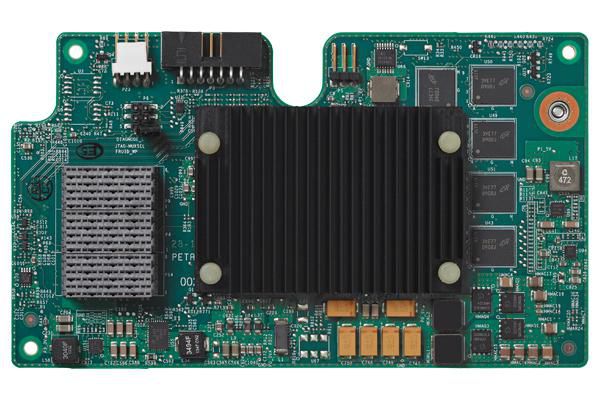- Início
- Redes
- Acessórios
- Placas de Rede
- Cisco UCS VIC 1340 MODULAR LOM **Refurbished** For Blade Servers – UCSB-MLOM-40G-03-RFB
Cisco UCS VIC 1340 MODULAR LOM **Refurbished** For Blade Servers
Este produto é usado ou recondicionado. Todos os acessórios podem NÃO estar incluídos.
MPN UCSB-MLOM-40G-03-RFB
Nível de stock
Superior Flexibility and Network Performance
The Cisco UCS Virtual Interface Card (VIC) 1340 is a 2-port, 40 Gigabit Ethernet, Fibre Channel over Ethernet (FCoE)-capable modular LAN on motherboard (mLOM) mezzanine adapter. This innovation is designed exclusively for the B200 M3 and M4 generation of Cisco UCS B-Series Blade Servers.
Features and Capabilities
Stateless and Agile
The capability to define, create, and use interfaces on demand provides a s...
Especificações para UCSB-MLOM-40G-03-RFB
Design
Component for
Server
Internal
Yes
Network
Maximum data transfer rate
40000 Mbit/s
Networking standards
IEEE 802.1Qaz, IEEE 802.1Qbb, IEEE 802.1p, IEEE 802.3ae, IEEE 802.3x
Operational conditions
Operating temperature (T-T)
10 - 35 °C
Package dimensions
Gross Weight (Package, kg)
1 kg
Ports & interfaces
Connectivity technology
Wired
Host interface
PCI Express
Interface
Fiber
Power
Power consumption (typical)
12 Watt
Product dimensions
Net Weight (Product, kg)
0,99 kg
Product Depth
18,4 cm
Product Width
9,3 cm
Vendor information
Brand Name
Warranty
1 Ano(s)
Descrição
Superior Flexibility and Network Performance
The Cisco UCS Virtual Interface Card (VIC) 1340 is a 2-port, 40 Gigabit Ethernet, Fibre Channel over Ethernet (FCoE)-capable modular LAN on motherboard (mLOM) mezzanine adapter. This innovation is designed exclusively for the B200 M3 and M4 generation of Cisco UCS B-Series Blade Servers.
Features and Capabilities
Stateless and Agile
The capability to define, create, and use interfaces on demand provides a stateless and agile server infrastructure. The personality of the card is determined dynamically at boot time using the service profile associated with the server. The service profile is used to determine the number of PCIe interfaces, their type (vNIC or vHBA), identity (MAC address) and World Wide Name (WWN), failover policy, bandwidth, and quality-of-service (QoS).
Next-Generation Data Center Features:
The hardware classification engine provides support for advanced data center requirements. These include:
- Stateless network offloads for Virtual Extensible LAN (VXLAN) and Network Virtualization using Generic Routing Encapsulation (NVGRE)
- Low-latency features of the Cisco user-space NIC (usNIC)
- High-bandwidth protocol RDMA over Converged Ethernet (RoCE)
- Performance-optimization applications such as Virtual Machine Queue (VMQ), Intel Data Plane Development Kit (DPDK), and Netflow
VXLAN
VXLAN enables overlay networks for virtual machines (VMs), allowing them to communicate or move between hosts within or between your data centers. It encapsulates Layer 2 frames within Layer 3 UDP packets, making the entire infrastructure appear as a local Layer 2 network.
NVGRE
NVGRE is a network virtualization technology that attempts to alleviate the scalability problems associated with large cloud computing deployments. It uses Generic Routing Encapsulation (GRE) to tunnel Layer 2 packets over Layer 3 networks.
usNIC
User space NIC improves the performance of software applications that use the Message Passing Interface (MPI) instead of sockets or other communication APIs. It does this through bypassing the OS kernel when sending and receiving networking packets. The applications interact directly with a Cisco UCS VIC, which improves the networking performance of your high-performance computing application.
RoCE
RoCE is a high bandwidth, low-latency protocol that has lower CPU utilization than traditional TCP/IP. It is targeted for HPC and Microsoft’s SMB Direct (Windows Server 2012/R2) environments.
VMQ
Virtual Machine Queue is a hardware virtualization technology for the efficient transfer of network traffic to a virtualized host OS. It uses DMA to transfer all incoming frames that should be routed to a receive queue to the receive buffers that are allocated for that queue.
DPDK
DPDK is designed for fast-packet processing on Intel® Xeon® processors. It is a set of software libraries that improves packet processing performance for the most demanding applications commonly found in telco and service provider networks.
NetFlow
NetFlow efficiently provides a key set of services for IP applications, including network traffic accounting, usage-based network billing, network planning, security, and network monitoring capabilities, such as Denial of Service (DoS). NetFlow provides valuable information about network users and applications, peak usage times, and traffic routing. Cisco invented NetFlow, and is a leader in IP traffic flow technology.
*Os dados do produto acima são fornecidos pela Icecat. A EET não pode ser responsabilizada por erros relacionados.

